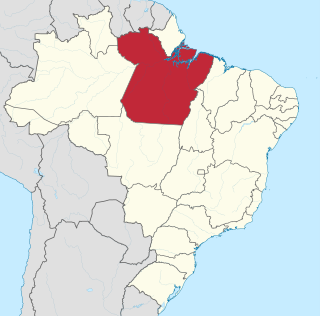
Santarém is a city and municipality in the western part of the state of Pará in Brazil. Located at the confluence of the Tapajós and Amazon Rivers, it has become a popular tourist destination. It is the second-most important city in the state, and the financial and economic center of the western part of the state. It leads the Santarém Metropolitan Area, made up of Santarém, Belterra and Mojuí dos Campos. It was once home to the Tapajós Indians, a tribe of Native Americans after whom the river was named. They were the leaders of a large, agricultural chiefdom that flourished before the arrival of Europeans.

The North Region of Brazil is the largest Region of Brazil, corresponding to 45.27% of the national territory. It is the least inhabited of the country, and contributes with a minor percentage in the national GDP and population. It comprises the states of Acre, Amapá, Amazonas, Pará, Rondônia, Roraima and Tocantins.

The açaí palm, Euterpe oleracea, is a species of palm tree (Arecaceae) cultivated for its fruit, hearts of palm, leaves, and trunk wood. Global demand for the fruit expanded rapidly in the 21st century and so the tree is cultivated for that purpose primarily.
Hélder Lima de Queiroz is a Brazilian conservation biologist, primatologist, and fish behaviorist.

The St. Clement of Ohrid University of Bitola is the second Macedonian state university located mainly in Bitola, with faculties in Prilep, Ohrid, Veles, Kichevo and Skopje. It was founded on 25 April 1979, but the name of St. Clement of Ohrid was not given until late 1994. The number of enrolled students exceeds 15,000.
Bioprocess engineering, also biochemical engineering, is a specialization of chemical engineering or Biological engineering, It deals with the design and development of equipment and processes for the manufacturing of products such as agriculture, food, feed, pharmaceuticals, nutraceuticals, chemicals, and polymers and paper from biological materials & treatment of waste water. Bioprocess engineering is a conglomerate of mathematics, biology and industrial design,and consists of various spectrums like designing of bioreactors, study of fermentors. It also deals with studying various biotechnological processes used in industries for large scale production of biological product for optimization of yield in the end product and the quality of end product. Bioprocess engineering may include the work of mechanical, electrical, and industrial engineers to apply principles of their disciplines to processes based on using living cells or sub component of such cells.
The Islamic Azad University, Lahijan Branch is a branch of the Islamic Azad University system.

The Roman Catholic Archdiocese of Belém do Pará is an archdiocese located in the city of Belém in Brazil.

Transilvania University of Brașov is a public institution of higher education in Brașov, Romania, founded in 1971. It has eighteen faculties, a total of over 19,000 students, and more than 700 academic staff. The University offers 105 days license areas, 12 areas for distance education, and 5 areas for higher reduced frequency, as well as 73 graduate programs and 18 doctoral programs.

The Paru River is a northern tributary of the lower Amazon in Pará state in north-central Brazil.
Gentile: Guamaenserio Guamá
Ukrainian Engineering Pedagogics Academy is a Ukrainian academy in Kharkiv.
The Federal University of Pará is one of the three public universities maintained by the Brazilian federal government in the state of Pará. It was ranked as the 15th largest Brazilian university in a 2011 academic ranking by the number of enrollments. The university has over 40,000 students enrolled in its courses, which are offered across its many campuses in the cities of Belém, Abaetetuba, Altamira, Ananindeua, Bragança, Castanhal, Cametá, Capanema, Breves, Tucuruí and Soure. Among UFPA research teams, there are many nationally recognized groups, particularly in the fields of genetics, parasitology, tropical diseases and geosciences. The Federal University of Pará is the largest university in the North region of Brazil by enrollment and is a reference in the areas of Biomedical Sciences and Biology research, this last one mainly because of the Amazon Rainforest.
Pará State University is the only public university maintained by the state government of Pará, Brazil. The university has over 14,000 students enrolled in its 57 courses, from which 23 are undergraduate and 34 are graduate programs. Those programs are offered across UEPA's 20 campuses in the cities of Belém, Paragominas, Conceição do Araguaia, Marabá, Altamira, Igarapé-Açu, São Miguel do Guamá, Santarém, Tucuruí, Moju, Redenção, Barcarena, Vigia de Nazaré, Cametá, Salvaterra, and Castanhal.

The Federal Institute of Pará is an institution of higher, vocational, and middle education maintained by the Brazilian federal government in the state of Pará. The institute has students enrolled in its courses offered across its many campuses in the cities of Belém, Abaetetuba, Altamira, Bragança, Castanhal, Cametá, Capanema, Breves, Tucuruí and Soure.

The Federal Rural University of Amazonia is a Brazilian public University located in Belem, Pará, Brazil
Campeonato Paraense Second Division is the second level of the Pará state professional football championship, one of the Brazilian state championships. This tournament is played by 10 teams, in which the two best teams are promoted to Campeonato Paraense.

Bogdan Khmelnitsky Melitopol State Pedagogical University is an Ukrainian university in Melitopol. It is one of the most developed universities in Zaporizhia, Ukraine. It was established in 1923, and is also one of the leading-state universities in the education of teachers.

















